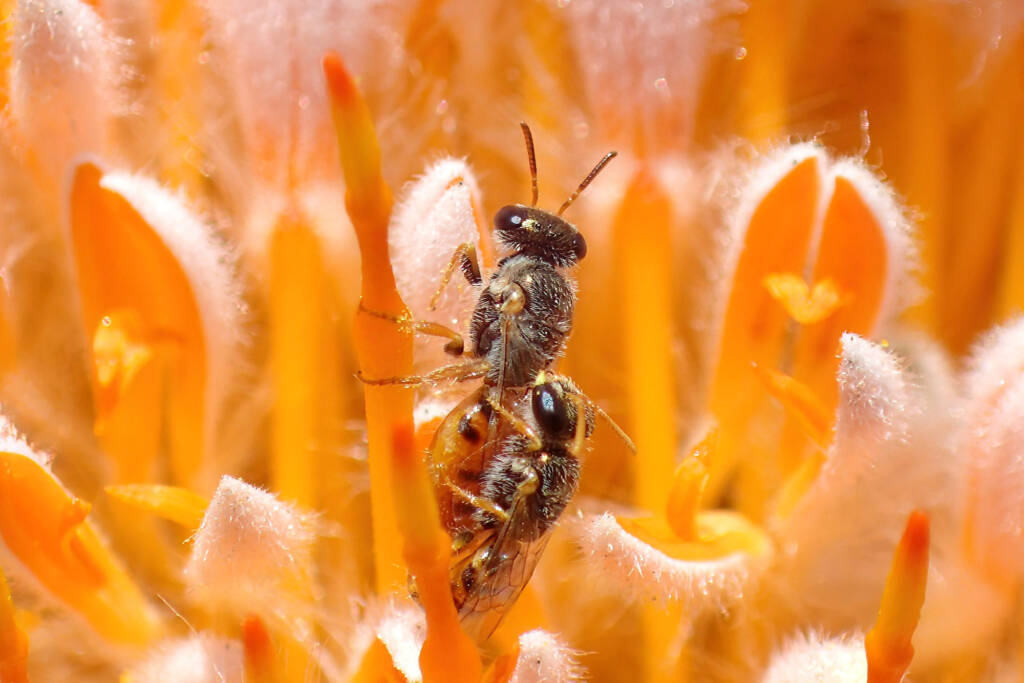Author Gary Taylor ◦
With the shortening of the days comes the flowering of the Banksias, and with them a whole new array of little native bees. And I make the point of saying “little” bees ‘cos apart from being at the tail end of the “big” bee season (I’ll get back to that…), the little ones in these pics belong to the Euryglossinae family (a subfamily of the Colletidae family) and they hold the record for the worlds smallest bee, Quasihesma… and it’s here in Aus, and apparently also in my area… 😃 For me it’s way high up on the bucket list of wanted bee photographs, and I’ve looked for it for years but at only 1.8 mm long and a soft yellow colour I’m stuffed if I can see the bloody thing… 😆 I did dead set think I saw one once on a big ol’ Tuart… the heart raced, this is it… I went into full AVWM mode (American in a Vietnam War Movie… that’s where you get so excited you just stand there blasting off hundreds of shots and hope you hit something 😂), I did get one or two in focus… turned out it was just a bloody fly… 😅

But back to the girl stuffing her face in the first pic… This little girl, like her nearest cousins the Hylaeines, doesn’t collect pollen externally for her offspring, she ingests it and mixes it with concentrated nectar to produce a thick nutritious baby food.

The 2nd pic shows the typical female bee posture, the 3rd and 4th pics show the typical male and the one way to tell them apart at a glance… Notice the body language, particularly the antennae… on the female they’re pointing down ‘cos what’s on her mind is providing the best food she can for her babies, she’s basically reading the Nutritional Information label on the jar. The male however doesn’t give a rats about nutritional info, he’s only got one thing on his mind (as seen in the 5th pic ) so being alert is his main objective… tho’ to bee fair, it IS his one and only job, and no one wants to be crap at their job… 😄

Another thing with Euryglossinae is some are so similar in appearance to Hylaeinae that it can be hard to distinguish between them, so the 4th pic is also a good example of one of the easiest ways to tell them apart… The location of the antennae. In the Euryglossines they are set below the mid-point of the eye, in Hylaeines they’re set above… Having said all that, my knowledge of them is still very limited, ID wise they’re like the last frontier for me, there’s so many that look so similar, but if I had to go to genus level to save my life I’d say Dasyhesma… and wince waiting for the firing squad… On my headstone will be the words I spoke in my dying breath… “Damn, I knew I should have said ‘Euhesma’…” 😆

Anyway, getting back to the end of the “big” bee season… Basically they’re all gone, just a couple of late emerging banded Amegilla left still buzzing around and they’re few and far between. In a couple of hours of searching for bees in general, I’d only seen one lonely Amegilla girl feeding all on her own. And not collecting pollen, which means she hadn’t found a mate… Then further down the track, a lonely male high speed searching the flowers for a female, zipping from one to the next with a buzz that sounded like a mix of desperation and worry that he may have missed the party… I actually find it sad to watch (mind you I also apologize to spiders if I accidentally break their web, and then try my best to fix it for them 😄), I wanted to tell him I’d spotted a lonely girl looking for love a little north of here but he just scrolled past like it was click bait… which in a way is kinda true 😅 But, the point is “why no more big bees?”… And despite being told by an “expert” on another page some years ago I was totally wrong (but not given any other valid explanation), to me it seems logical, a small dark coloured mass heats up quicker in sunlight than a larger light coloured one… I mean come on, even the ants know that and will replace the white rocks they use to reflect heat from around their nest entrance in summer with small dark stones to absorb the warmth in winter… 🙂

Photographs © Gary Taylor
